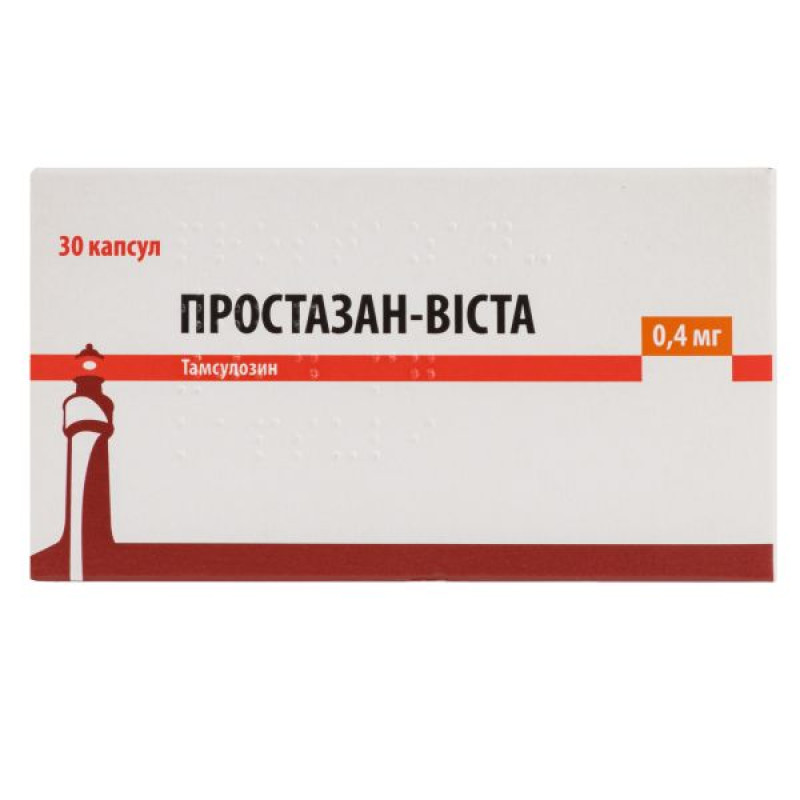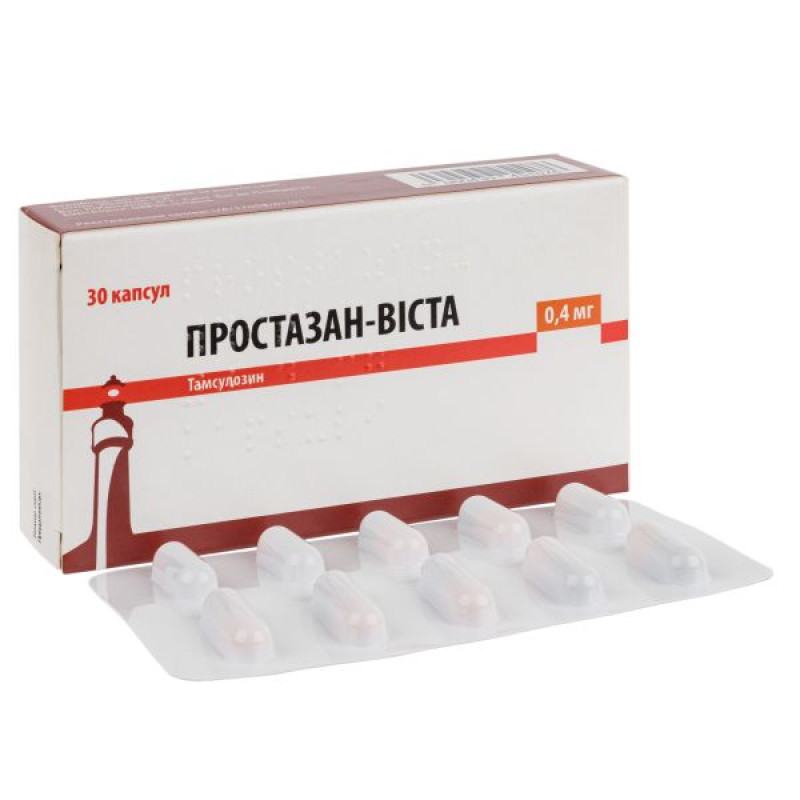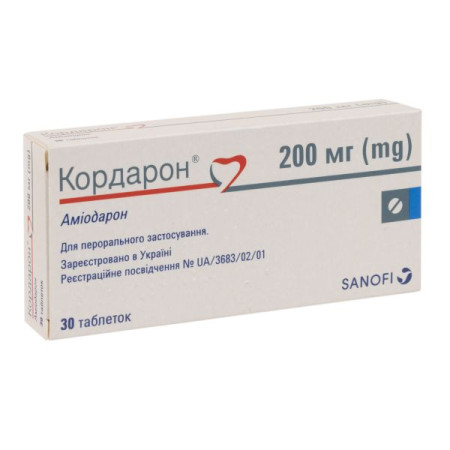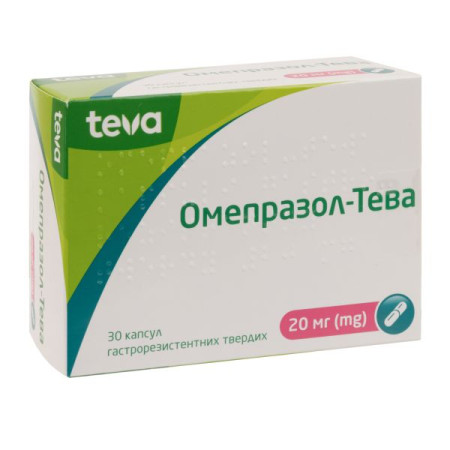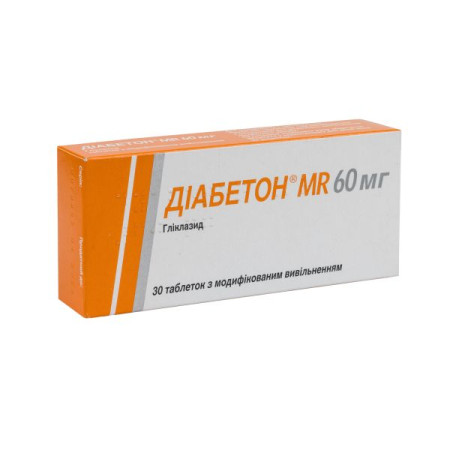Prostazan-Vista modified-release capsules 0.4 mg blister No. 30
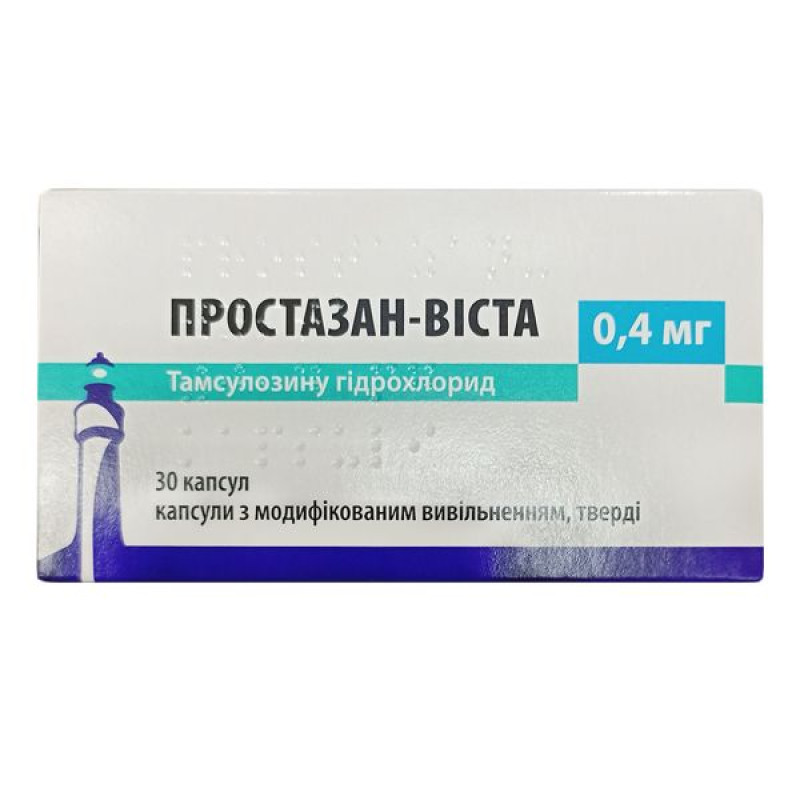
Instructions for Prostazan-Vista modified-release capsules 0.4 mg blister No. 30
Composition
active ingredient: tamsulosin hydrochloride;
1 capsule contains 0.4 mg of tamsulosin hydrochloride;
excipients: microcrystalline cellulose, dispersion of 30% methacrylate acid - ethyl acrylate copolymer (1:1) containing polysorbate 80 (about 2.8%), sodium lauryl sulfate (about 0.7%), triethyl citrate, talc;
Pellet coating: dispersion of 30% methacrylate acid - ethyl acrylate copolymer (1:1), containing polysorbate 80 (about 2.8%), sodium lauryl sulfate (about 0.7%), talc, triethyl citrate;
capsule composition: gelatin, indigotine (E 132), titanium dioxide (E 171), yellow iron oxide (E 172), red iron oxide (E 172), black iron oxide (E 172).
Dosage form
Modified-release capsules, hard.
Main physicochemical properties: hard gelatin capsule with an orange body and an olive cap. The capsule is filled with white to almost white pellets.
Pharmacotherapeutic group
Drugs used in benign prostatic hyperplasia. α1-adrenergic receptor antagonists. ATC code G04C A02.
Pharmacological properties
Pharmacodynamics
Tamsulosin selectively and competitively blocks postsynaptic α1-adrenoceptors, in particular α1A and α1D, located in the smooth muscles of the prostate gland, bladder neck and prostatic urethra. This leads to a decrease in the tone of the smooth muscles of the prostate gland, bladder neck and prostatic urethra, which contributes to improved urine output. At the same time, the symptoms of obstruction and irritation associated with benign prostatic hyperplasia are reduced (difficulty starting urination, weakening of the urine stream, dribbling after urination, feeling of incomplete bladder emptying, frequent urination, urge to urinate at night, urgency to urinate).
These effects persist for a long time with long-term treatment and significantly discourage surgery or catheterization.
Alpha-1 adrenoceptor antagonists have the ability to lower blood pressure by reducing peripheral vascular tone. No clinically significant reduction in blood pressure was observed in studies with tamsulosin.
Pharmacokinetics
Absorption. Tamsulosin is well absorbed from the gastrointestinal tract, and its bioavailability is almost 100%. Absorption of tamsulosin occurs somewhat more slowly after food intake. Absorption uniformity is achieved when the patient takes tamsulosin at the same time after a meal. The pharmacokinetics of tamsulosin are linear.
After a single dose of tamsulosin after a meal, peak plasma concentrations of tamsulosin are reached after approximately 6 hours, and steady-state concentrations are reached by the fifth day after daily administration of tamsulosin. Cmax is approximately two-thirds higher than that achieved after a single dose.
Distribution: In men, tamsulosin is approximately 99% bound to plasma proteins. The volume of distribution of tamsulosin is small (approximately 0.2 l/kg).
Metabolism: Tamsulosin hydrochloride is not subject to the first-pass effect and is slowly metabolized in the liver to form pharmacologically active metabolites that retain high selectivity for α1-adrenoceptors. Most of the active substance is present in the blood in unchanged form.
Elimination: Tamsulosin and its metabolites are excreted mainly in the urine. Approximately 9% of the dose remains as unchanged active substance.
After a single dose of tamsulosin after a meal and at steady state, the half-lives are approximately 10 and 13 hours, respectively.
Indication
Treatment of functional disorders of the lower urinary tract in benign prostatic hyperplasia.
Contraindication
Hypersensitivity to tamsulosin hydrochloride, including drug-induced angioedema, or to any of the excipients; history of orthostatic hypotension; severe hepatic impairment.
Interaction with other medicinal products and other types of interactions
Interaction studies were conducted only with the participation of adults.
No drug interactions have been observed when tamsulosin hydrochloride is used concomitantly with atenolol, enalapril, nifedipine or theophylline. Concomitant use with cimetidine increases and furosemide decreases the plasma concentration of tamsulosin, but since these levels remain within the normal range, no special dosage adjustment of tamsulosin is required.
However, diclofenac and warfarin may increase the elimination rate of tamsulosin. Concomitant use of tamsulosin hydrochloride with strong CYP3A4 inhibitors may lead to increased exposure to tamsulosin hydrochloride. Concomitant use with ketoconazole (a known strong CYP3A4 inhibitor) resulted in a 2.8- and 2.2-fold increase in AUC and Cmax, respectively.
Tamsulosin hydrochloride should not be administered in combination with strong CYP3A4 inhibitors in patients with poor CYP2D6 metabolism.
Tamsulosin hydrochloride should be used with caution in combination with strong and moderate CYP3A4 inhibitors.
Concomitant use of tamsulosin hydrochloride and paroxetine (a strong CYP2D6 inhibitor) leads to an increase in Cmax and AUC by 1.3 and 1.6 times, respectively, but this is not clinically significant.
Concomitant use with other α1-adrenergic blockers may enhance the hypotensive effect.
Application features
As with other α1-adrenergic blockers, in rare cases, tamsulosin may cause a decrease in blood pressure, which can sometimes lead to loss of consciousness. At the first signs of orthostatic hypotension (dizziness, weakness), the patient should be in a sitting or lying position until the above symptoms disappear.
Before starting the use of Prostazan-Vista, a medical examination should be performed to identify other concomitant diseases that may cause the same symptoms as benign prostatic hyperplasia. Before starting treatment, a rectal examination of the prostate gland should be performed and, if necessary, a test to determine the level of prostate-specific antigen (PSA) before the start and at equal intervals during treatment. The drug should be prescribed with special caution to patients with severe renal insufficiency (creatinine clearance < 10 ml/min), since clinical studies of tamsulosin in such patients have not been conducted.
Some patients who have taken or are taking tamsulosin have experienced atonic pupil syndrome (IFIS, a variant of pinhole pupil syndrome) during cataract and glaucoma surgery, which may lead to an increased number of complications during or after such surgery.
It is generally recommended that tamsulosin be discontinued 1–2 weeks before cataract and glaucoma surgery, but the benefit of such discontinuation of tamsulosin has not been clearly established. Atonic pupil syndrome has also been observed in patients who have discontinued tamsulosin long before cataract surgery. Patients are not recommended to start tamsulosin hydrochloride before elective cataract or glaucoma surgery. In preparation for surgery, surgeons and ophthalmologists should inquire whether the patient has taken (or is taking) tamsulosin in order to prevent possible complications associated with IFIS.
Tamsulosin hydrochloride should not be administered in combination with strong CYP3A4 inhibitors in patients with poor CYP2D6 metabolism.
Tamsulosin hydrochloride should be used with caution in combination with strong and moderate CYP3A4 inhibitors (see section "Interaction with other medicinal products and other types of interactions").
Cases of allergic reactions to tamsulosin have been reported in patients with a history of allergy to sulfonamides. Caution should be exercised when administering tamsulosin hydrochloride to patients with a history of allergy to sulfonamides.
Important information about excipients.
This medicinal product contains less than 1 mmol sodium/dose, i.e. essentially sodium-free.
Use during pregnancy or breastfeeding
Prostazan-Vista is not indicated for use in women.
Fertility.
Ejaculation disorders have been reported in short- and long-term clinical trials with tamsulosin. Cases of ejaculation disorders, retrograde ejaculation and insufficient ejaculation have been reported in the post-marketing period.
Ability to influence reaction speed when driving vehicles or other mechanisms
Studies on the effects of tamsulosin on the ability to drive or use machines have not been conducted. However, patients should be warned about the possibility of drowsiness, blurred vision, dizziness and fainting.
Method of administration and doses
The recommended dose for adults is 1 capsule daily after breakfast or after the first meal. The capsule should be swallowed whole, do not break or chew, as this will prevent the modified release of the active ingredient.
Patients with renal insufficiency do not require dose adjustment. Patients with mild to moderate hepatic insufficiency do not require dose adjustment. (see also section "Contraindications").
Children
The medicine should not be used in children.
The safety and efficacy of tamsulosin in children (under 18 years of age) have not been evaluated.
Overdose
Symptoms.
Overdose of tamsulosin hydrochloride can potentially cause severe hypotensive effects. Severe hypotensive effects have been observed with varying degrees of overdose.
In case of a sharp decrease in blood pressure due to overdose, supportive therapy should be carried out, aimed at restoring normal cardiovascular function (for example, the patient should take a horizontal position). If this measure is ineffective, infusion therapy and vasopressors should be prescribed. It is necessary to monitor renal function and carry out general supportive therapy. Given the high degree of binding of tamsulosin to plasma proteins, it is unlikely that hemodialysis is advisable.
In order to stop further absorption of tamsulosin, vomiting can be induced artificially. In case of overdose with a significant amount of tamsulosin, the patient should be washed with activated charcoal and low-osmotic laxatives, such as sodium sulfate.
Side effects
All adverse reactions are listed by organ system and frequency.
| Body system | Common (> 1/100, < 1/10) | Uncommon (> 1/1000, < 1/100), | Rare (> 1/10,000, < 1/1,000) | Very rare (< 1/10,000) | Frequency not known (cannot be estimated from the available data) |
| Nervous system | Dizziness (1.3%) | Headache | Fainting (syncope) | ||
| Organs of vision | Blurred vision*, visual impairment* | ||||
| Heart | Feeling your heart beating (palpitations) | ||||
| Vessels | Orthostatic hypotension | ||||
| Respiratory system, thoracic organs and mediastinum | Rhinitis | Nosebleed* | |||
| Gastrointestinal tract | Constipation, diarrhea, nausea, vomiting | Dry mouth* | |||
| Skin and subcutaneous tissue | Rash, itching, hives | Angioedema | Stevens-Johnson syndrome | Erythema multiforme*, exfoliative dermatitis*, photosensitivity reactions* | |
| Reproductive system and mammary glands | Ejaculation disorders, including retrograde ejaculation and ejaculatory failure | Priapism | |||
| General condition and injection site condition | Asthenia |
* Observed in the post-registration period.
During post-marketing surveillance, cases of intraoperative iris instability (pinched pupil syndrome) during cataract and glaucoma surgery have been described in patients taking tamsulosin (see section "Special warnings and precautions for use"). Post-marketing experience. In addition to the above adverse reactions, cases of atrial fibrillation, arrhythmia, tachycardia and dyspnea have been reported. As with other alpha-blockers, drowsiness, dry mouth, edema may occur. Since these cases were reported spontaneously, the frequency of reports and the role of tamsulosin in this cannot be reliably established.
Reporting of suspected adverse reactions.
Reporting adverse reactions after registration of a medicinal product is of great importance. This allows monitoring of the benefit/risk ratio when using this medicinal product. Medical and pharmaceutical professionals, as well as patients or their legal representatives, should report all cases of suspected adverse reactions and lack of efficacy of a medicinal product via the Automated Information System for Pharmacovigilance at the link: https://aisf.dec.gov.ua
Expiration date
3 years.
Storage conditions
Store at a temperature not exceeding 25 ° C in the original packaging. Keep out of the reach of children.
Packaging
10 capsules in a blister, 3 blisters in a cardboard box.
Vacation category
According to the recipe.
Producer
Sinton Hispania, S.L.
Location of the manufacturer and address of its place of business
Calle C/Castello, no. 1, Sant Boi de Llobregat, Barcelona, 08830, Spain
There are no reviews for this product.
There are no reviews for this product, be the first to leave your review.
No questions about this product, be the first and ask your question.




